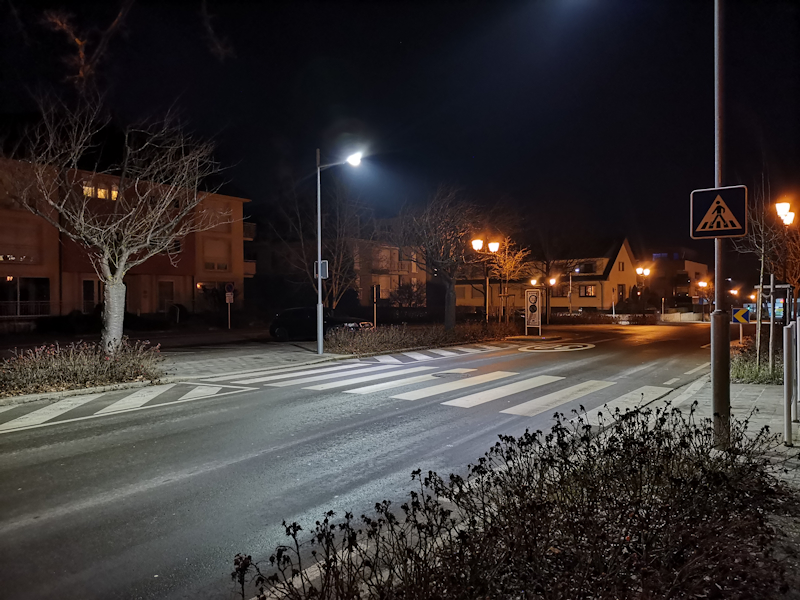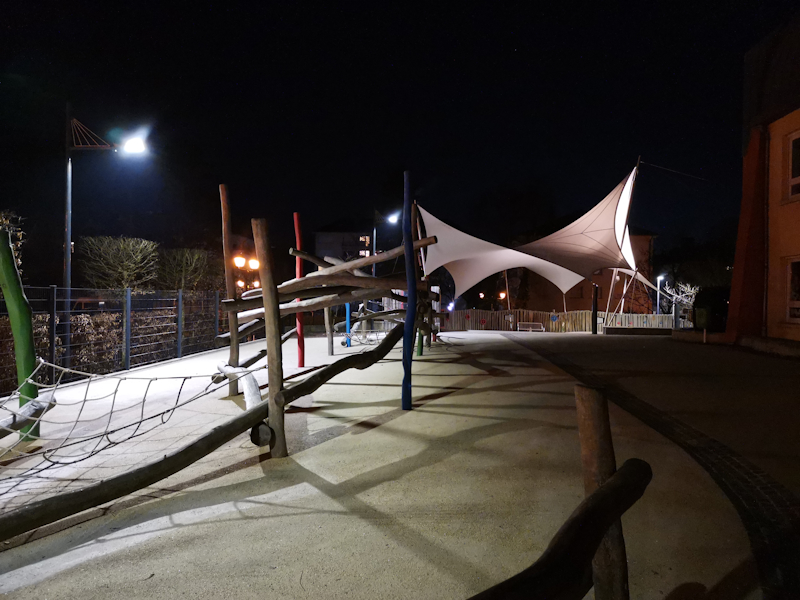Honor Launches The View20: A 48MP Camera Review
by Andrei Frumusanu on January 28, 2019 8:00 AM EST- Posted in
- Smartphones
- Mobile
- Kirin 980
- Honor View20
Camera - Low Light Evaluation
Low-light testing on the View20 is interesting. Here on one hand we should see the advantages of the big sensor in its pixel-binning mode, but on the other hand this might be a regression compared to the bigger 1µm 40MP sensors of the Huawei counterparts. Much like the P20 Pro and Mate 20 Pro, the View20 lacks an OIS mechanism that not only represents a disadvantage in terms of video recording, but also low-light capture. Let’s see how the new Honor device ends up in terms of low-light capture.

[ Honor View20 ] - [ Mate 20 Pro ]
[ Mate 20 ] - [ Galaxy Note9 ] - [ Galaxy S9+ ] - [ LG V40 ]
[ OnePlus 6T ] - [ Pixel 3 ]
The first shot unfortunately does confirms some of my fears about the new sensor: Although at first glance the result is very similar to the Mate 20 Pro, under closer inspection the View20 does have overall worse details and less sharp edges than what the flagship counterpart can achieve. Unfortunately this is a simple matter of light capture ability on the part of the sensor, and here the View20 only achieves 64% of the per-pixel area compared to the Mate 20 Pro.
The View20’s strength remains its processing ability, which still allows it to achieve quite good results compared to the competition.
The 48MP clear mode in effect is again no better than the 12MP mode, both in detail and exposure. We’ll see this behaviour to be true of all the low-light shots, and in effect I would have wished Honor’s software would have just reverted to a 12MP shot instead of needlessly generating a 48MP file.

[ Honor View20 ] - [ Mate 20 Pro ]
[ Mate 20 ] - [ Galaxy Note9 ] - [ Galaxy S9+ ] - [ LG V40 ]
[ OnePlus 6T ] - [ Pixel 3 ]
The next shot the View20 also ends up strikingly similar to the Mate 20 Pro. The phone’s advantages over the classical competition here isn’t solely due to the sensor, but as demonstrated by the regular Mate 20, can be largely attributed by the image processing and ISP of the new Kirin SoC.

[ Honor View20 ] - [ Mate 20 Pro ]
[ Mate 20 ] - [ Galaxy Note9 ] - [ Galaxy S9+ ] - [ LG V40 ]
[ OnePlus 6T ] - [ Pixel 3 ]
In extreme low-light, the View20 seemed to have issues focusing correctly as all my 12MP shots ended up being blurry. The 48MP clear mode shots here better demonstrated the raw capture ability of the sensor, and it ends up with quite a good representation of the scene.
Switching over to the night mode, we get a significantly better result of the moonlit scene. In terms of pure light capture ability, the phone still lags behind Google’s Night Sight mode on the Pixel 3, even although this latter result is fantastically over-the-top in terms of how bright it managed to make this dark scene.
Overall, good low-light capture
Overall the View20’s low light capture ability is very similar to the Mate 20 Pro and more recent Huawei devices. This means that they’re quite top performers exceeding the ability of classical smartphone cameras which don’t employ new computational photography modes.










37 Comments
View All Comments
apphil - Monday, January 28, 2019 - link
One thing I am extremely curious is the performance of the GPS chip as it is one of the first phones with L5 GPS and this should increase accuracy a lot. Can you guys comment on that or maybe test that, as better navigation and positioning would be a very interesting feature for me.Andrei Frumusanu - Monday, January 28, 2019 - link
One of the benefits of this was in more urban areas with tall buildings, unfortunately I wasn't able to actually test this out. The phone's location APIs also does not disclose whether it sees L5 satellites or not - usually you see it when there's a duplicate ID, however this does not appear on the View20.808Hilo - Monday, January 28, 2019 - link
The cam is disappointing. Can we just have a big sensor and a manual lensring of my choice and 4k or 8k raw at 30fs the back. NOW!!!Its not difficult. Just do it. Nikon in my case. I got a nice selection of 8-50mm lenses and dont want yours.
Engineering a phone is not difficult. Adding a lensring and a big sensor is a breeze.
Valantar - Monday, January 28, 2019 - link
Difficult? Not if you don't care about size, no. The flange distance of the Nikon Z-mount is 16mm, for their F-mount it's 46.5mm. Add a handful of mm to that for the display, and 10 or so for the sensor and shutter array - more if you want IS. That's a chunky phone, even with a Z-mount. And constructing lenses for shorter flange distances with large sensors is _extremely_ difficult, as you'll have to correct for ever more distortions towards the outer parts of the sensor. Of course they could have spacer rings or similar to adapt lenses, but that would kind of defeat the point, no? You wouldn't be able to fit it in your pocket unless you're wearing MC Hammer pants. Also, 8k30 in a phone? At what bitrate, 50Mbps? For any bitrate worth the pixels in 8k, you'd need storage in the several-hundred-GB amounts for even a collection of short clips, and the processing power needed would require large interchangeable batteries - unless you want your phone to die after filming for 5 minutes? And good luck getting that video material off a phone with non-removable storage in a reasonable amount of time. I suppose you'd want it to have an SSD bay too?hanselltc - Monday, January 28, 2019 - link
>Engineering a phone is not difficultbuild ur own phone m8 :v
Manch - Monday, January 28, 2019 - link
TOF sensor would be great for 3D scanning! Why not have an app to take advantage!jabber - Monday, January 28, 2019 - link
You know I'd settle for a truly excellent 8MP main cam to be honest.Forget going mega megapixel. Just get the fundamentals right first.
shabby - Monday, January 28, 2019 - link
Nothing to do with megapixels in this case, the sensor is great, everyone uses sony sensors, its the isp and software that sucks. The isp on these chinese made soc's is way behind the snapdragon isp.Heck even sony doesn't know how to fully take advantage of its own sensor. The pixel 3 and pocophone use the same sensor and we all know which phone takes the best photo's.
Midwayman - Monday, January 28, 2019 - link
Yes. This. Especially with more phones putting on more than a single lens. I care way more about the quality of the pixels than the quantity of pixels. 48mp photos just take up more space if they are just a grainy mess in anything but the brightest light.jabber - Tuesday, January 29, 2019 - link
Exactly. They spend all the time fussing over the sensor and then throw out the lens/flash/focusing/software/compression/NR features.I bet the sensors from 4 years ago would beat most current flagships if they bothered to spend more than a weeks development on all the other fundamentals.